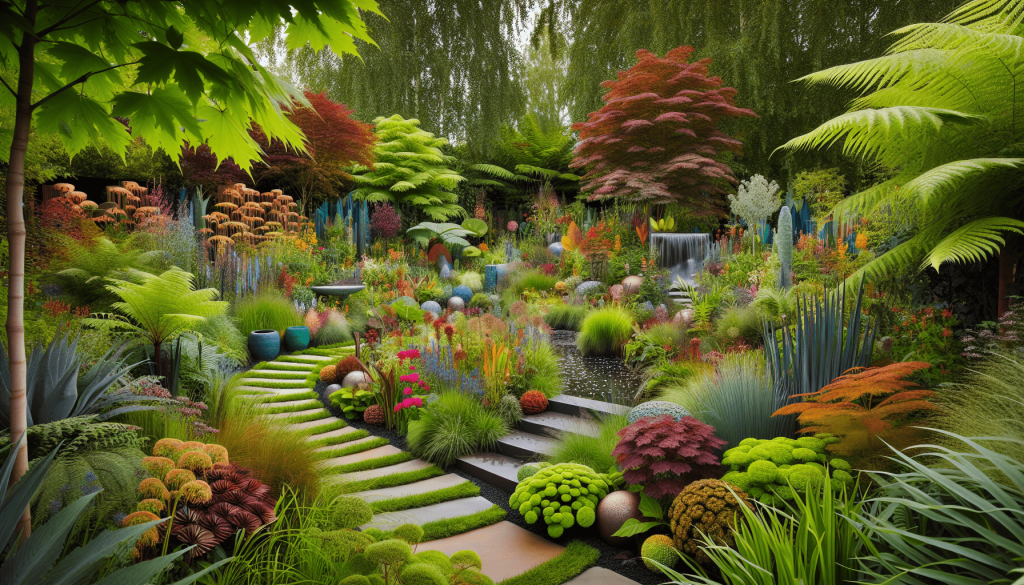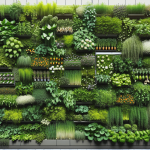This post may contain affiliate links. As an Amazon Associate, we may earn commissions from qualifying purchases.
Creating a sensory garden for children and adults is an enriching experience that offers a multi-sensory environment where everyone can relax, explore, and engage with nature. By incorporating a variety of plants, textures, colors, sounds, and scents, you can design a garden that stimulates the senses and provides numerous therapeutic benefits. From the feel of soft leaves to the sound of rustling grasses and the scent of fragrant flowers, every element can be carefully selected to create a harmonious and inviting space. This guide will walk you through step-by-step on how to plan, plant, and maintain a sensory garden that appeals to both children and adults, ensuring a delightful experience for visitors of all ages.
How Do I Create A Sensory Garden For Children And Adults?
Have you ever wondered how you can create a sensory garden that caters to both children and adults? If so, you’re in the right place! Designing a sensory garden can be a wonderful way to engage the senses, stimulate the mind, and provide a therapeutic environment for everyone to enjoy. Whether it’s the feel of different textures, the soothing sounds of nature, or the myriad of scents from various plants, a sensory garden can deliver an immersive experience for people of all ages.

What is a Sensory Garden?
A sensory garden is a specially designed outdoor space that focuses on stimulating the five senses: sight, sound, touch, taste, and smell. It’s an inclusive, therapeutic garden environment that can offer relaxation, excitement, and educational opportunities. Sensory gardens are particularly beneficial for children, adults, and individuals with sensory processing difficulties, autism, or other disabilities.
Benefits of a Sensory Garden
The advantages of having a sensory garden are plentiful. From emotional well-being to physical health, such gardens create a myriad of benefits:
- Educational Opportunities: Perfect for children to learn about nature and different senses.
- Mental Health Benefits: Great for reducing stress and anxiety.
- Physical Exercise: Encourages movement and physical activity.
- Enhanced Sensory Skills: Helps develop or improve sensory skills through various activities.
- Inclusivity: An inclusive space for individuals with various disabilities to enjoy and learn.
Planning Your Sensory Garden
Creating a sensory garden requires thoughtful planning and consideration to ensure it meets the needs and interests of both children and adults.
Determine Your Objectives
Start by identifying the primary goals of your sensory garden. Is it for educational purposes, relaxation, therapy, or general enjoyment? Knowing your objectives will guide your design choices and help you prioritize various elements.
Choose a Suitable Location
Selecting the right location is crucial. Ideally, it should be a quiet, secure area where users can fully engage with the sensory elements without distractions. Ensure the area gets adequate sunlight and has good soil quality for plant growth.
Think About Accessibility
Ensure your garden is easily accessible to everyone, including individuals with mobility issues. Wide, flat pathways made of non-slip materials can make it easier for wheelchairs and strollers. Consider using tactile paving for individuals with visual impairments.
Designing Your Sensory Garden
Once you’ve laid the groundwork, it’s time to move on to the design phase. Your sensory garden should engage all five senses to create a holistic and immersive experience.
Engaging the Sense of Sight
Visual elements are one of the easiest and most impactful ways to engage garden visitors.
Colorful Plants and Flowers
Opt for a variety of colorful plants and flowers to create visual interest. Consider including plants that bloom at different times of the year to ensure your garden remains vibrant throughout the seasons.
| Plant | Color | Bloom Time |
|---|---|---|
| Marigold | Orange/Yellow | Summer-Fall |
| Lavender | Purple | Spring-Summer |
| Sunflower | Yellow | Summer |
| Pansy | Multicolor | Fall-Spring |
Garden Art
Incorporate garden sculptures, colorful pots, and decorative stones to add artistic flair. These elements can make the garden more visually appealing and provide focal points for visitors.
Engaging the Sense of Sound
Sound can add an entirely new dimension to your sensory garden. Natural and artificial sounds can both be effective.
Water Features
A small pond, fountain, or a trickling stream can add soothing water sounds that enhance the calming atmosphere of your garden.
Wind Chimes and Bells
Hang wind chimes, bells, or other musical objects from trees or structures. The gentle sounds produced by these instruments can be incredibly soothing and can help foster relaxation.
Engaging the Sense of Touch
The sense of touch is often overlooked but can add a rich, tactile experience to your garden.
Variety of Textures
Incorporate plants and materials with varying textures. Think about using smooth stones, rough tree bark, soft moss, and fuzzy leaves. Raised beds or planters can make it easier for everyone to reach and explore these textures.
| Plant/Material | Texture |
|---|---|
| Lamb’s Ear (Plant) | Soft/Fuzzy |
| Tree Bark | Rough |
| Moss | Soft |
| Ornamental Grasses | Feathery |
Sensory Pathways
Design pathways with different textures, such as pebbles, sand, or wooden planks, to provide a tactile walking experience.
Engaging the Sense of Smell
Scent plays a powerful role in our sensory experiences and memories. Incorporating fragrant plants can add an aromatic layer to your garden.
Fragrant Flowers and Herbs
Select plants that have strong, pleasant scents to stimulate the sense of smell. Here are some options:
| Plant | Scent |
|---|---|
| Lavender | Floral/Herbal |
| Rosemary | Woody |
| Jasmine | Sweet/Floral |
| Mint | Fresh/Herbal |
Aromatic Oils and Incense
In areas where planting extensive fragrant plants is not possible, consider placing diffusers with essential oils or periodically burning incense to maintain a fragrant environment.
Engaging the Sense of Taste
While taste may seem difficult to incorporate, planting edible elements can make it possible.
Edible Plants and Fruits
Plant a variety of fruits, vegetables, and herbs. Children and adults can enjoy picking and tasting them while learning about gardening and healthy eating.
| Plant | Edible Part |
|---|---|
| Strawberries | Fruits |
| Cherry tomatoes | Fruits |
| Basil | Leaves |
| Blueberries | Fruits |
Sensory Eating Spaces
Create cozy nooks or seating areas where visitors can sit and enjoy their freshly picked produce. Picnic tables or benches can provide nice spots for garden dining.
Safety Considerations
Safety is paramount, especially if the garden is intended for children, the elderly, or individuals with disabilities.
Non-Toxic Plants
Ensure that all plants used are non-toxic. Some common garden plants can be harmful if ingested or touched. Here are some plants to avoid:
| Plant | Toxicity |
|---|---|
| Foxglove | Highly Toxic |
| Oleander | Highly Toxic |
| Daffodils | Toxic |
| Rhubarb (Leaves) | Toxic |
Safe Pathways
Ensure pathways are even and free of obstacles. Use non-slip materials to prevent accidents, especially in wet conditions.
Supervision and Monitoring
Always ensure children and adults who may need assistance are supervised and accompanied while in the garden. Install clear signage for rules and guidelines to ensure everyone stays safe.

Maintenance and Upkeep
A sensory garden requires regular maintenance to keep it inviting and safe for users.
Regular Inspections
Conduct regular inspections to check for overgrown plants, damaged pathways, and worn-out features. Make necessary repairs promptly to maintain safety and accessibility.
Seasonal Care
Different plants require different care throughout the year. Create a maintenance calendar to ensure tasks like pruning, weeding, and fertilizing are carried out as needed.
Involve the Community
Engage the community in the maintenance of the garden. This can be an excellent way to foster a sense of ownership while also ensuring that the garden remains well-tended.
Tips for Engaging Activities
A sensory garden can offer more than just a passive experience. Organize activities to engage both children and adults.
Nature-Based Crafts
Host workshops where participants can create crafts using natural materials from the garden, such as leaf printing or making flower crowns.
Sensory Games and Activities
Create games that focus on sensory experiences. For example, a touch-and-feel scavenger hunt can encourage participants to explore different textures.
Educational Tours
Arrange guided tours to educate visitors about the different plants and their sensory properties. This can be especially beneficial for school groups or therapy sessions.
Conclusion
Creating a sensory garden for children and adults is a rewarding endeavor that offers numerous benefits. By thoughtfully engaging all five senses and considering accessibility and safety, you can create a space that provides joy, relaxation, education, and therapeutic benefits. As you embark on this journey, remember to involve your community, stay flexible with your design, and most importantly, have fun creating a beautiful and inclusive outdoor sanctuary.
Feel free to share your experiences and tips in creating your sensory garden, and happy gardening!








